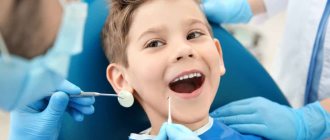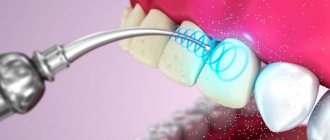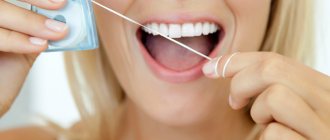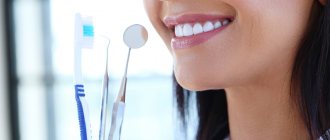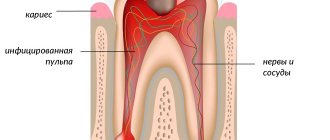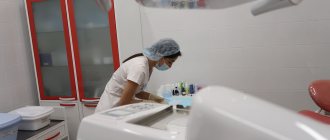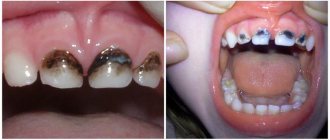Anna Andreevna Bespalova, a dentist-therapist at the Denta-El clinic, talks about what procedures are necessary to prevent and protect against oral diseases, as well as how to effectively combat diseases such as caries, stomatitis, etc.
It is common knowledge that poor oral hygiene is the root cause of all problems. However, not everyone understands why hygiene is so important. Without constant care, accumulations of plaque (at first soft) form in the mouth, becoming an ideal breeding ground for bacteria.
They digest plaque and release acids that negatively affect teeth. The layers of calcium are washed away and the enamel dissolves, becoming brittle. As a result, so-called demineralization of the enamel is observed, which ultimately leads to the formation of caries.
In childhood, this often manifests itself as white (sometimes yellow) spots on the teeth on the front side. The next stage after this is caries.
Peculiarities
Visiting the dentist from an early age helps avoid fear of dental treatment in the future.
Hygiene for children has such features.
- The procedure is carried out quickly (the kids do not get tired).
- Special brushes (with high speed) and pastes are used.
- Remove soft and hard plaque, pigmented plaque, polish the enamel with special pastes;
- After the procedure, the enamel is coated with a special agent (varnish or solution) to saturate the tooth with calcium, fluorine and phosphorus ions.
How to do oral hygiene for children under one year old
Oral care is necessary from birth, despite the absence of baby teeth. Parents should ensure that the baby does not develop thrush, a fungal disease that manifests itself as a white coating on the tongue and cheeks. When a baby's first baby tooth appears, it is necessary to properly care for it. Dentists advise using dental wipes. They are impregnated with xylitol, so they do not cause allergic reactions. The products have a pleasant fruity aroma.
When the first teeth appear, you need to buy a brush with soft bristles. Toothpaste can be used according to age, the very first from 0 to 3, as it is safe to swallow, since the baby does not know how to spit it. You will need to squeeze out a small amount of paste.
How to remove plaque
Removing soft and hard plaque from teeth seems to be an elementary procedure, but, nevertheless, it requires the specialist, in addition to attention, to have some experience in such operations . The soft coating is removed with special rubber bands (or a brush). As a rule, children do not object to this - they do not experience discomfort or pain as a result of the procedure . But the importance of such a procedure is difficult to overestimate - despite its apparent simplicity, it can become an important preparation for subsequent treatment, accustoming the child to manipulations in the oral cavity.
In the case of tartar, special devices - ultrasonic or manual.
Children's hygiene rules
Parents should consult a professional hygienist. He will show your child the correct technique for brushing his teeth. Oral care for children should include:
- Brushing your teeth twice a day.
- Replace your toothbrush 1-3 times a month.
- Using the right paste.
- Storing a clean brush in a special case with the bristles facing up.
- Using dental floss.
- Brushing time is at least two minutes.
- Consuming sweets in minimal quantities.
It is necessary to visit a pediatric dentist once every 4 months, even if there are no dental problems.
Competent selection of hygiene products for children
Oral hygiene can be a pleasant experience if you teach your child to brush their teeth correctly from an early age. Doctors advise:
- Buy your baby's first brush with very soft bristles.
- Change your toothbrush as recommended by your pediatric dentist or dental hygienist.
- Parents and children should choose the first brushes with a long handle for cleaning their teeth.
- Buy toothpaste according to the baby's age.
- Choose safe toothpastes.
Modern techniques in treating children
Pediatric dentistry at SM-Doctor in Moscow is a team of experienced doctors who have been working with children of any age for many years.
No matter how frightened a child or teenager is, our dentists will find an approach to him, relieve him of fear and tension, interest him and carry out manipulations without pain and fear. The equipment in the clinic’s offices is new and easy to use for both doctors and young patients. Doctors use only high-quality materials in their work, tested by experience and meeting the standards of the Russian Federation and the world.
We will not only provide high-quality cleaning of your child’s teeth, but also teach him the rules of dental and gum hygiene. Let's get children interested using playful techniques so that you no longer have to force them to brush their teeth.
Choosing a toothpaste
You can use toothpaste from the appearance of the first tooth. Gels and organic pastes are recommended for baby teeth. The packaging must indicate that the product is not hazardous if swallowed. The amount of paste should be no more than a pea. Requirements for hygiene products for babies:
- gum care;
- antibacterial effect;
- gentle and high-quality cleaning of enamel;
- pleasant taste;
- absence of harmful components.
How to teach hygiene to a child in a fun way
The procedure can become exciting if:
- buy accessories with your favorite cartoon characters;
- choose toothpaste with the flavor of your favorite berries or fruits;
- purchase flashing brushes (flashes for two minutes, indicating the required time for the procedure);
- allow the child to choose a brush or toothpaste;
- find interesting educational videos or games aimed at developing the correct technique for brushing your teeth.
The easiest way to teach children proper hygiene is by example. Arrange joint procedures, fill out special calendars, and the kids will brush their teeth with pleasure.
Basic mistakes
The main mistakes in oral hygiene include:
- Wrong size brush: too big.
- Incorrectly selected bristles: too soft or hard.
- Short duration of teeth brushing.
- Incorrect movements of the toothbrush.
- Ignoring tongue cleaning.
Remember, it is difficult to retrain a child to do anything. Therefore, dentists emphasize that it is important to teach proper oral care from early childhood.
Reviews
Cleaning a child's teeth at the dentist is an important undertaking, so it is important that it is carried out by a good specialist, and that the chosen clinic has a good reputation. Therefore, we care very much about our reputation and strive to ensure that every little patient is satisfied with the service. And how well we do this, you can judge by the reviews that we always publish unchanged.
Gum care in the first months of life
Caring for a baby's gums in the first months of life is of great importance. Dentistry "Novostom" has prepared a memo for parents.
- After each feeding, wipe the baby's gums with gauze or special wipes.
- Do not put your baby to bed with a bottle of formula (even worse than juice), as they contain a lot of sugar.
- Baby teeth need to be brushed after they emerge. To do this, use a brush or a silicone fingertip (without paste).
- Visit your dentist regularly.
Proper oral care in children can eliminate the need for future treatment. Entrust the health of your children to dental professionals.
The article was prepared by an expert:
Banina Ella Sergeevna
Dental hygienist
Make an appointment
Professional teeth cleaning for children of all ages
The hygiene of baby teeth is just as important as the hygiene of permanent teeth. The well-being and mood of the baby, and in the future, the formation of a correct permanent bite, with which the child will have to live his whole life, directly depends on their health. No matter how hard she tries, a mother cannot brush her child’s baby teeth thoroughly enough, so professional cleaning at this age is especially important. Using a soft brush, the doctor will carefully clean each tooth, and at the same time make sure that there is no caries or other diseases.
It is important to consider that a child develops three different bites at different times:
- milk (up to 4-5 years);
- replaceable (up to 14-15 years);
- permanent (15 and older).
From about 5 to 14 years of age, a child has both primary and permanent teeth. This combination is called a mixed bite (or mixed). The main feature of a mixed bite is that the teeth have different heights, and this complicates self-cleaning.
This is also a very important period, since it is at this age that a permanent bite is formed, with which the child will have to live his entire adult life. It is important to avoid inflammatory processes, caries and other oral diseases that can affect the growth and formation of permanent teeth.
It is important to know! Many parents are sure that their children do not develop tartar. But in the oral cavity of a child, the same processes occur as in adults, and therefore the stone is formed in the same way. It's just not as noticeable in children because they don't smoke, drink coffee or drink tea in the same quantities as adults.
By the age of 14-15, children have only permanent teeth. Usually a child at this age already knows how to clean them on his own, without missing hard-to-reach places. But it’s still worth signing him up for professional cleaning, since the doctor will be able to tell him what mistakes he’s making.
Cost of children's oral hygiene
| Name | Cost, rub. |
| Comprehensive oral hygiene (deciduous occlusion) 1. determination of the hygiene index. 2. removal of dental plaque with ultrasound. 3. Air flow removal of dental plaque. 4. polishing teeth. 5. training in proper brushing of teeth. 6. recommendations for the selection of oral hygiene products. | 2200 |
| Comprehensive oral hygiene (changeable bite) 1. determination of the hygiene index. 2. removal of dental plaque with ultrasound. 3. Air flow removal of dental plaque. 4. polishing teeth. 5. training in proper brushing of teeth. 6. recommendations for the selection of oral hygiene products. | 3190 |
Visiting the dentist:
- Twice a year
Examination of children for early diagnosis of dental caries and its complications. Detection of dental anomalies and early orthodontic treatment. Monitoring the condition of the gums and periodontal tissues. Recommendations for brushing teeth. Selection of oral hygiene products. Removing dental plaque and plaque (if necessary). Sealing of dental fissures
Brushing your teeth: In the morning after breakfast and in the evening before bed. Teeth brushing time – 3 minutes.
Basic oral hygiene products:
- Manual toothbrush/ electric toothbrush
- Toothpaste (as recommended by a dentist)
A manual toothbrush should have: medium-hard bristles; rounded and polished bristle tips; a rounded head shape corresponding to the size of the teeth; small head, which ensures maneuverability in the oral cavity; volumetric handle for better grip of the brush in your hand.
For children over six years old, we can recommend an electric children's toothbrush: with soft two-level bristles; with indication of bristle wear; with a round head.
Additional oral hygiene products are used on the recommendation of a dentist and under the supervision of parents from 7-9 years:
- Dental floss
- Rinse aid
- Chewing gum without sugar with xylitol
- Foams
- Tongue scraper
- Dental brushes
Using dental floss (FLOSSA)
Starting from the age of 7, it is necessary to introduce the use of dental floss into personal hygiene. This is especially indicated for children with a high risk of caries, with crowded teeth, and those undergoing orthodontic treatment using fixed orthodontic appliances.
It is recommended to use dental floss before brushing your teeth with toothpaste, and if you use a mouthwash, then after toothpaste, before the rinsing procedure. Dental floss, or floss, was developed specifically for cleaning the contact surfaces of teeth that are difficult to reach with a brush.
Mouth rinse is recommended as an additional hygiene product, because... It cleans the interdental spaces well and has a deodorizing effect. The rinse aid must contain fluoride and not contain alcohol. Rinse your mouth for 1 minute, do not swallow.
The use of dental rinses allows you to destroy a significant part of the bacteria remaining after brushing. By improving the condition of the gums, the risk of periodontitis and other dental diseases is reduced. Teeth rinses help maintain their whiteness, strengthen enamel, fight the formation of tartar and prevent the formation of caries.
Foam is used to clean teeth when it is not possible to use a regular toothbrush. The action of foams is expressed in cleaning and leveling the acid-base balance in the oral cavity, which prevents the growth of dental plaque and the development of pathogenic microorganisms in it.
Xylitol (xylitol) has pronounced anti-caries properties: it has a specific antimicrobial effect against the most cariogenic microorganisms, accelerates salivation, improves self-cleaning of the oral cavity and increases the ability of saliva to strengthen tooth enamel. The use of chewing gum containing xylitol is recommended after meals for 10-15 minutes.
ATTENTION! However, it must be remembered that excessive intake of xylitol into the body can lead to unwanted side effects, as it promotes diarrhea. The daily dose of xylitol for an adult is from 30 to 50 grams.
Professional oral hygiene (teeth brushing) is a system of treatment and preventive measures performed in a dental clinic, aimed at preventing the occurrence and progression of oral diseases. In this case, the doctor or hygienist removes plaque and tartar and polishes the surfaces of the teeth.
Professional oral hygiene should be carried out at least once a year.
Nutrition:
Products that are healthy for teeth should contain a small amount of sugar and sufficient amounts of vitamins and minerals. It is good to eat solid foods.
Avoid eating sugar-containing foods (sweets, cookies, etc.) between main meals.
Avoid drinking sugary carbonated drinks.
| Healthy foods for teeth Raw vegetables and fruits Nuts, dried fruits Milk, cheese, meat Fish, tea | Harmful foods for teeth Caramel, lollipops, chocolate Sweet carbonated drinks Sugar-containing chewing gum |
At the age of 6-15 years, the temporary teeth are replaced by permanent teeth.
Timely and consistent teething indicates the normal development of the child’s body. Violation of the timing and sequence of eruption can occur with endocrine and metabolic disorders or general diseases of the child.
Dental caries
Dental caries is a disease of hard dental tissues that occurs due to irregular oral hygiene and excessive consumption of sweets.
Damage to teeth by caries is always accompanied by a violation of their function; when teeth are destroyed, difficulties arise when eating, pain, disturbances in appearance, especially when caries affects the anterior group of teeth. Caries of temporary and permanent teeth in children occurs with the same unpleasant sensations as in adults.
From the age of 6, temporary teeth begin to fall out and permanent teeth erupt.
The first permanent molars appear in the oral cavity as the very first of the permanent teeth behind the temporary molars at the back, so parents do not pay enough attention to these teeth, not noticing them.
Maturation of enamel (strengthening) continues after teething in the oral cavity, so it is extremely important to create adequate conditions for this process: for this it is necessary to carry out professional oral hygiene with the application of special mineral gels, and thoroughly brush your teeth at home.
Attention!!! On the chewing surfaces of the first permanent molars, deep pits (fissures) are often identified, which are primarily affected by caries. To protect against caries, immediately after the eruption of these teeth, it is necessary to carry out a sealing technique, which includes filling the fissures with a special material.
Therefore, it is important to visit the dentist on time to identify caries, its treatment and prevention, both in temporary and even more so in permanent teeth.
IMPORTANT!
If dark gray spots appear on the teeth, if the teeth react to cold, hot, sweet, sour, and even more so, if carious cavities are visible on the teeth, then the child clearly has caries. You need to contact your dentist immediately! If there is crowding of teeth, a permanent tooth did not erupt smoothly or at the wrong time, if bleeding occurs when brushing your teeth, you should immediately contact your dentist!
Remember that you should contact the dentist when the child is healthy and does not experience toothache!
